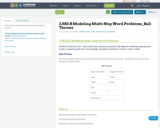
This task provides Grade 3 students with modeling practice.
- Subject:
- Education
- Elementary Education
- Mathematics
- Numbers and Operations
- Material Type:
- Activity/Lab
- Assessment
- Homework/Assignment
- Date Added:
- 08/15/2018

This task provides Grade 3 students with modeling practice.
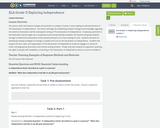
Lesson OverviewThis lesson, which will require multiple class periods to complete, involves a close reading of selected portions of The Declaration of Independence. The lesson will begin by establishing students’ background knowledge regarding the American Revolution and the subsequent writing of The Declaration of Independence. Vocabulary pertinent to the Declaration will be taught via a vocabulary board and periodically reviewed. The teacher will guide students through a PowerPoint presentation of the essential elements of a close reading of a text. Students will work on developing reading strategies to manage a complex text such as the Declaration of Independence. Students will analyze the tone, style, and organization of The Declaration of Independence as well as engage in a variety of small- and large-group discussions and routine writing activities. Finally, they will compose an argument, asserting the rights of people with disabilities, connecting to The Declaration of Independence and as a source of evidence.Teacher Planning, Examples of Response Methods and MaterialsSee Full Lesson Plan AttachedEssential Question and NCSC Essential UnderstandingIs independence better described as a goal or a journey?Modified: “What does independence look like in my life goal and journey?”
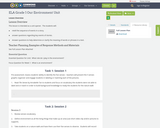
Lesson OverviewThis lesson is intended as a unit opener. The students will:● retell the sequence of events in a story.● answer questions regarding key events of stories.● Answer questions to help determine or clarify the meaning of words or phrases in a text.Teacher Planning, Examples of Response Methods and MaterialsSee Full Lesson Plan AttachedEssential QuestionEssential Question for Unit: What role do I play in the environment?Focus Question for Week 1: What is an environment?
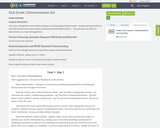
Lesson OverviewThis lesson is designed to help students develop an understanding of determination. Students will look at pictures and read text that shows determination. Students will identify determination. They will write and reflect on determination as a real world application.Teacher Planning, Examples Response Methods and MaterialsSee Full Lesson Plan AttachedEssential Question and NCSC Essential UnderstandingWhat are the challenges and barriers faced when people show determination?Identify a character, setting, event or conflict.Identify the topic of a text or information presented in a diverse media.Given a specific purpose, produce a permanent product.
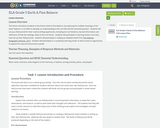
Lesson OverviewThis lesson introduces students to the theme, Earth-A Fine Balance, by exploring the multiple meanings of the word “balance” in an effort to develop an understanding of the unit title and the essential question. Students will set up a Field Journal for their routine writing experiences, including but not limited to, learned information and reflections of how the readings relate to the unit theme. Students will participate in learning centers once they have set up their field journals. Students will participate in reading an adapted article from The National Geographic Almanac, 2013. Students will participate in a vocabulary learning center as well as have an opportunity to explore the natural environment outside.Teacher Planning, Examples of Response Methods and MaterialsSee Full Lesson Plan AttachedEssential Question and NCSC Essential UnderstandingWhen nature interacts, what happens to the harmony, or balance, among animals, plants, and people?
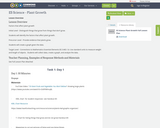
Lesson OverviewFactors that affect plant growthInitial Level - Distinguish things that grow from things that don’t grow.Students will identify the factors that affect plant growth.Precursor Level - Provide evidence that plants grow.Students will create a graph given the data.Target Level - Connections to Mathematics Essential Elements EE.5.MD.1.b: Use standard units to measure weight and length of objects. Students will collect data, create a graph, and analyze the data.Teacher Planning, Examples of Response Methods and MaterialsSee Full Lesson Plan Attached

During days 3-6 of the unit, students will complete a short, focused research assignment to learn about the characteristics of Sourthern Gothic Literature and to begin to view To Kill a Mockingbird through that lens. As is true with the rest of the unit, the three day time frame is a suggestion only and can be adjusted based on your schedule and the needs of the students.Image source: "Mockingbird" by skeeze on Pixabay.com.

Students will read and analyze a short story from the Southern Gothic genre entitled "The Life you Save May be Your Own" by Flannery O'Conner. They will continue to explore the ideas of human compassion and morality by examining the apparent lack of compassion in the characters of Mr. Shiftlet and the old woman, Lucynell Crater. Students will use close reading strategies to identify examples of indirect characterization that contribute to their analysis of these two central characters in the text. Image source: "Mockingbird" by skeeze on Pixabay.com.
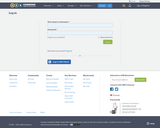
The purpose of Design Dilemma is to encourage students to use resourceful and creative behaviors to think like a scientist. Students will demonstrate these behaviors to design and build a suitable structure for a fourth little pig. Although the use of the book The Fourth Little Pig is helpful, the module may be taught without it. This module is meant for all students. The classroom teacher should work with a specialist or special educator to find or develop alternate activities or resources for visually impaired students, where appropriate.

Image source: "Writing" by Ramdlon at https://pixabay.com/en/writer-writing-paper-letter-author-605764/Unit Overview: The Writers on Writing Unit engages students in reading, analyzing, and creating literacy narratives, or stories about learning to read and write. The unit begins by asking students to view and read literacy narratives, and to analyze author’s literacy narratives through annotation, discussion, and writing a formal analysis essay. As students go through the narratives, they are asked to analyze author technique and purpose, paying close attention to style, syntax, and organization in preparation for writing their own authentic literacy narratives and ultimately creating digital storytelling projects about those narratives. By the end of this unit, students will have composed analysis writing, creative nonfiction, and multimedia stories. They will have had the ability to select certain reading assignments, to work in groups and with partners to brainstorm, edit, and revise, and they will have had guided writing lessons on composing strong sentences. Day 2 Overview: These plans are for Day 2 of the Writers on Writing Unit. On Day 2, students focus on strong sentences and paragraphs, beginning with student rewriting of mentor sentences, and culminating in analysis of a basic vs. elaborate paragraph from a literacy narrative. Students discuss how description improves meaning in narratives, and look at successful authors to prepare for their own work.Source Citation: Douglass, Frederick. Narrative of the Life of Frederick Douglass, an American Slave. Boston: Anti-Slavery Office, 1849.

Unit Overview: The Writers on Writing Unit engages students in reading, analyzing, and creating literacy narratives, or stories about learning to read and write. The unit begins by asking students to view and read literacy narratives, and to analyze author’s literacy narratives through annotation, discussion, and writing a formal analysis essay. As students go through the narratives, they are asked to analyze author technique and purpose, paying close attention to style, syntax, and organization in preparation for writing their own authentic literacy narratives and ultimately creating digital storytelling projects about those narratives. By the end of this unit, students will have composed analysis writing, creative nonfiction, and multimedia stories. They will have had the ability to select certain reading assignments, to work in groups and with partners to brainstorm, edit, and revise, and they will have had guided writing lessons on composing strong sentences. Days 11 to 15 Overview: These plans are for Days 11 to 15 of the Writers on Writing Unit. In this lesson, students expand their written literacy narratives into digital storytelling skills, drawing on all previous lessons and professional videos and narratives to compose their own multimedia videos for presentation. Image source: "Be creative" by Ramdlon on Pixabay.com

Unit Overview: The Writers on Writing Unit engages students in reading, analyzing, and creating literacy narratives, or stories about learning to read and write. The unit begins by asking students to view and read literacy narratives, and to analyze author’s literacy narratives through annotation, discussion, and writing a formal analysis essay. As students go through the narratives, they are asked to analyze author technique and purpose, paying close attention to style, syntax, and organization in preparation for writing their own authentic literacy narratives and ultimately creating digital storytelling projects about those narratives. By the end of this unit, students will have composed analysis writing, creative nonfiction, and multimedia stories. They will have had the ability to select certain reading assignments, to work in groups and with partners to brainstorm, edit, and revise, and they will have had guided writing lessons on composing strong sentences. Days 3 to 5 Overview: These plans are for Days 3 to 5 of the Writers on Writing Unit. On day 3, students listen to podcasts about different perspectives on struggling to read. They then complete a pre-assessment, reading and analyzing a literacy narrative with guided style analysis notes. Students will then review the pre-assessment activity in preparation for reading their own selections of professional literacy narratives on day 2. The lesson will culminate with students writing an analysis of a professional literacy narrative. Image source: "Idea" from Pxhere.com
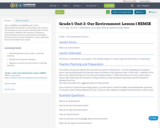
This is a REMIX of the MSDE Grade 1, Unit 1 Environment Lesson Plan 1. In this lesson, the students will be going on a nature walk to identify what is in their environment. Students will continue to develop an understanding of the word, environment, throughout the lesson and unit. They will listen to a story read aloud about how the Earth was created.
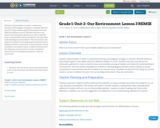
Students will participate in either a cooperative learning activity (jigsaw strategy) or a teacher directed activity to help students gather information about the different habitats on earth. Students will share and discuss the information gathered in order to identify some commonalities among all habitats and relate this understanding to environments. Then the teacher will guide the students in developing generalizations about habitats and their connections to environments overall. (A habitat is an animal’s home. A habitat includes all of the things the animal needs to survive. A habitat it found in the surrounding environment. They are connected.)
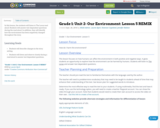
In this lesson, the students will listen to The Lorax read aloud. Students will answer text-dependent questions during the read aloud. In addition, they will identify how the environment has been negatively changed throughout the story.
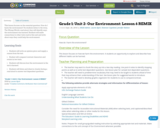
This lesson focuses on the essential question: How do I harm the environment? As students listen to the story, The Wump World, read aloud, they will identify ways the environment was harmed. Students will make connections to other texts read in this unit and write about ways they could help the environment.
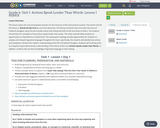
This lesson opens the unit and prepares learners for the structure of the instructional routines. The anchor text for this lesson is, Words Set Me Free by Lesa Cline-Ransome. This literary nonfiction text chronicles the story of Frederick Douglass' early life and includes events that influenced both his life and those of others. The students should listen for examples of how actions speak louder than words. The initial read will allow students an opportunity to comprehend on a literal level. The subsequent readings provide opportunities for students to analyze and interpret figurative language throughout the book. Specifically, the students will identify how similes and metaphors enhance the reader's understanding of the life of Frederick Douglass. Students will routinely write in a response log to demonstrate understanding of the theme of this unit, Actions Speak Louder than Words. In addition, students will use their knowledge of figurative language in their writing.

This lesson guides students in an examination of a poet's use of figurative language and word choice to convey themes of belonging and identity. Students will delve into the concept of the unit theme, “Belonging” and the essential question, "In what ways does our need to feel a sense of belonging conflict with our individuality?" Students will write a short essay analyzing the ways in which a poet uses figurative language and word choice to convey the speaker's sense of him/herself as an individual and as someone who feels he/she is not accepted. Image source: "Attain" by Nick Youngson from TheBlueDiamondGallery.com at http://thebluediamondgallery.com/tablet-dictionary/a/attain.html Creative Commons 3 - CC BY-SA 3.0

Lesson Overview Each student will write a journal entry about how motivation and perspective influence a dream. In addition, students will focus on how these influences can lead to a flawed dream. Students will read, analyze, and discuss the poem, “Dreams” by Langston Hughes, Martin Luther King’s “I Have a Dream” speech, excerpts from Chasing Lincoln’s Killer—Introduction—From 1861 through 1865 and pages 138-139, and the article, “Booth’s Reason for Assassination” by Christopher Hamner. Students will write an essay about John Wilkes Booth. In successive days, students will draft, revise, edit, and publish their essays. Image source: "Dream" by EvelynGiggles on Flickr.com. Licensed with CC-BY-2.0
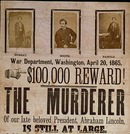
In this lesson, students will read chapters 9-14 in James L. Swanson’s, Chasing Lincoln's Killer to analyze and discuss how Swanson presents the repercussions of John Wilke’s Booth’s assassination of President Abraham Lincoln. Students will also compare Swanson’s account to a multimedia version of Booth’s escape after the assassination of Lincoln. Cover image source: "John Wilkes Booth Wanted Poster" edited from the original from the Library of Congress at https://www.loc.gov/item/96521960/